Answered step by step
Verified Expert Solution
Question
1 Approved Answer
GLOBAL SOURCING AT NIKE 1. Identify the Ethical dilemma in the case 2. Alternatives to Ethical Dilemma 3. Conclusion of the Case NaE.N-HE MSIE.A MicaA
GLOBAL SOURCING AT NIKE
1. Identify the Ethical dilemma in the case
2. Alternatives to Ethical Dilemma
3. Conclusion of the Case
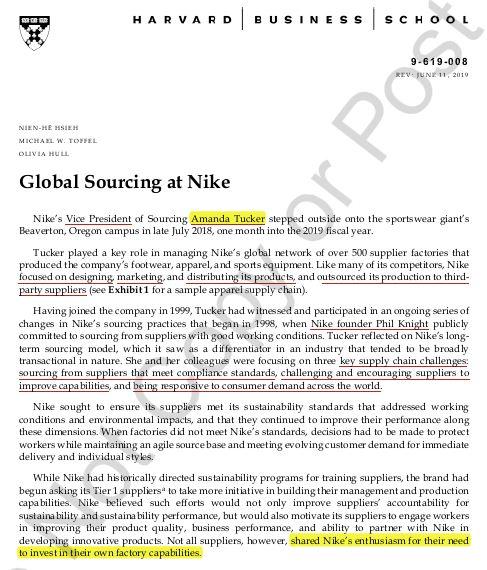
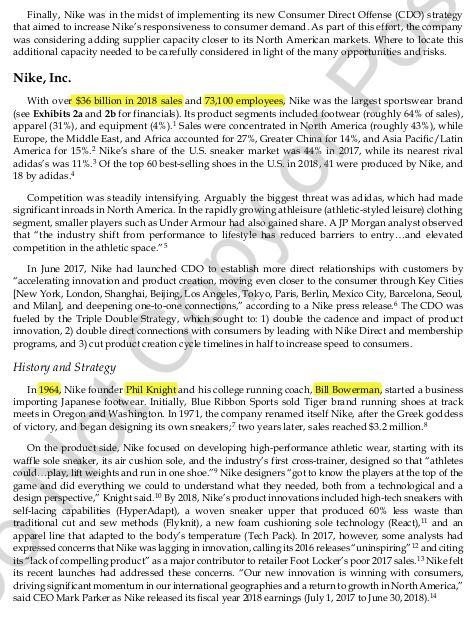
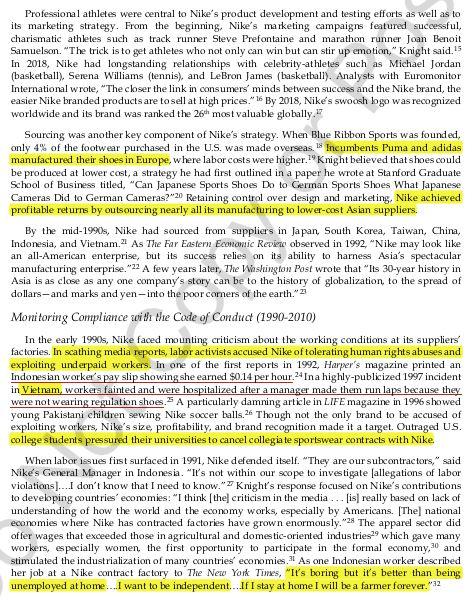
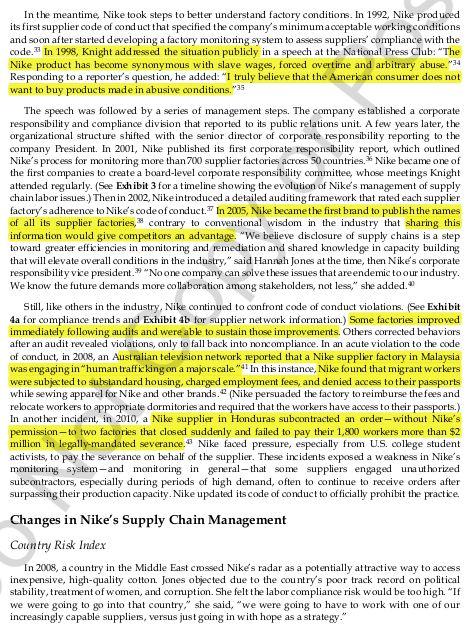
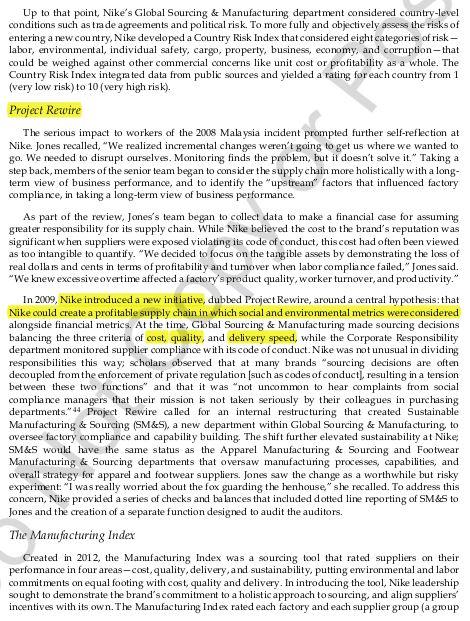

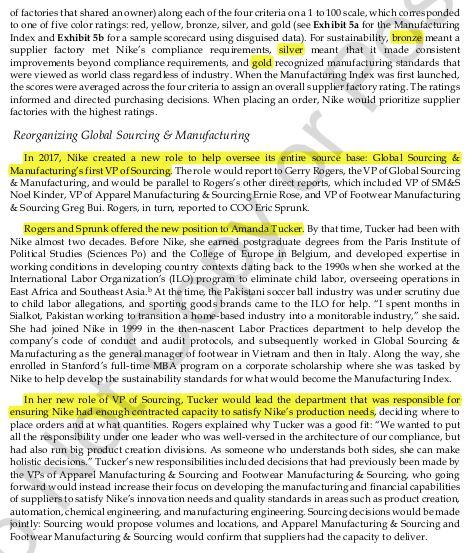
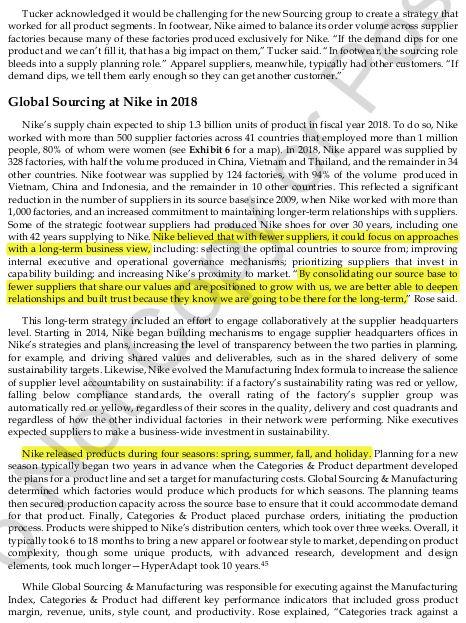

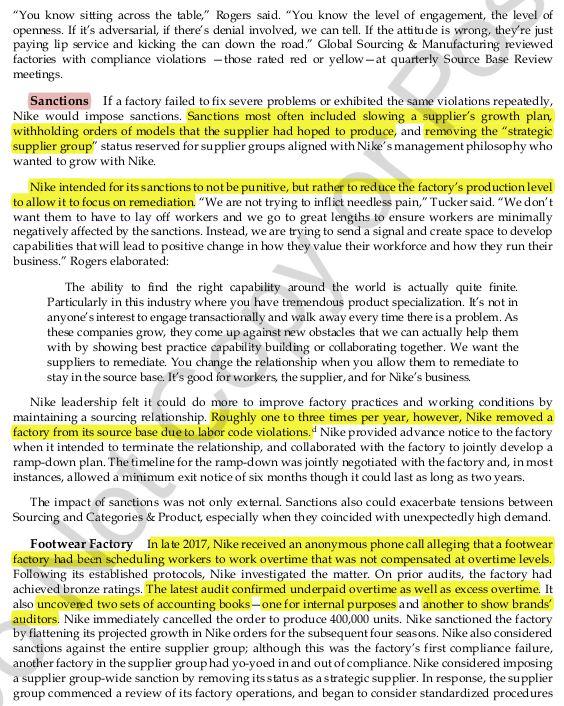
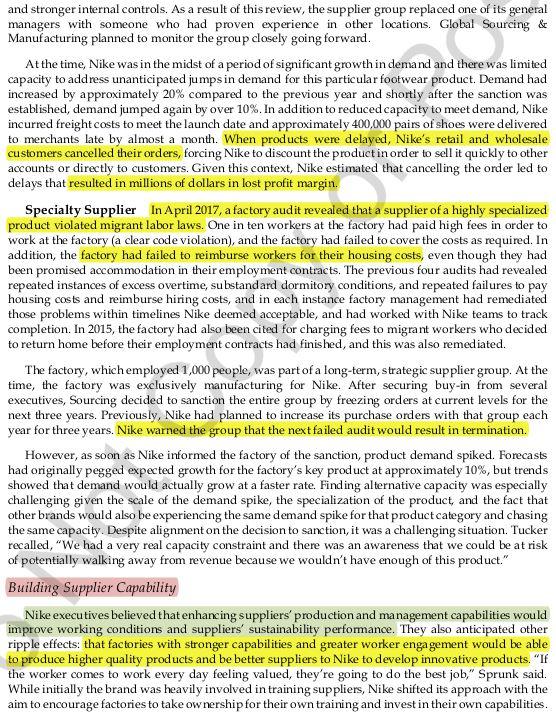
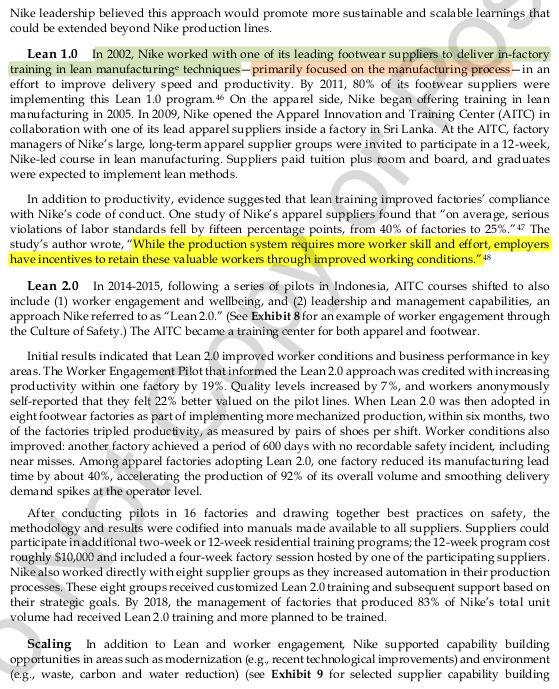
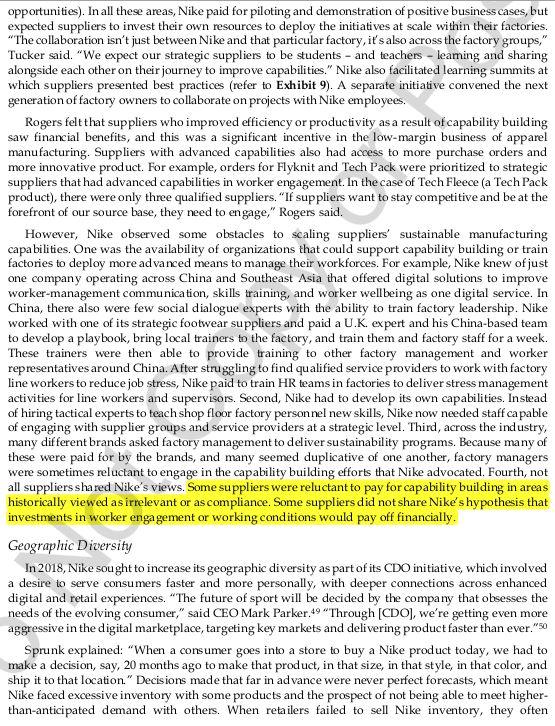
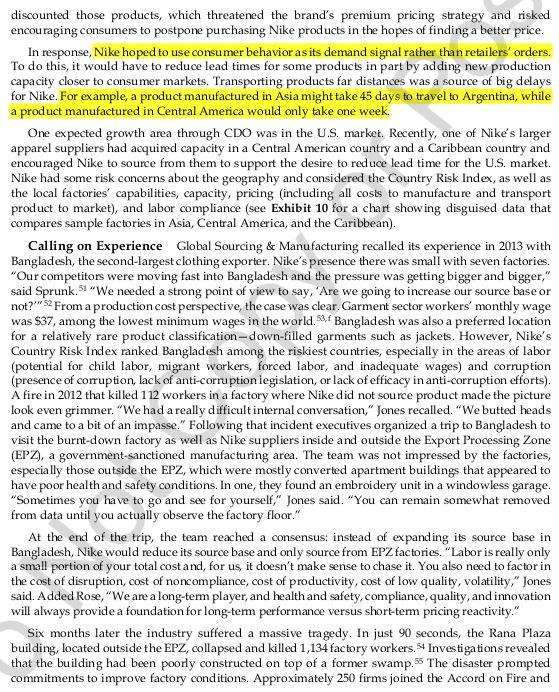
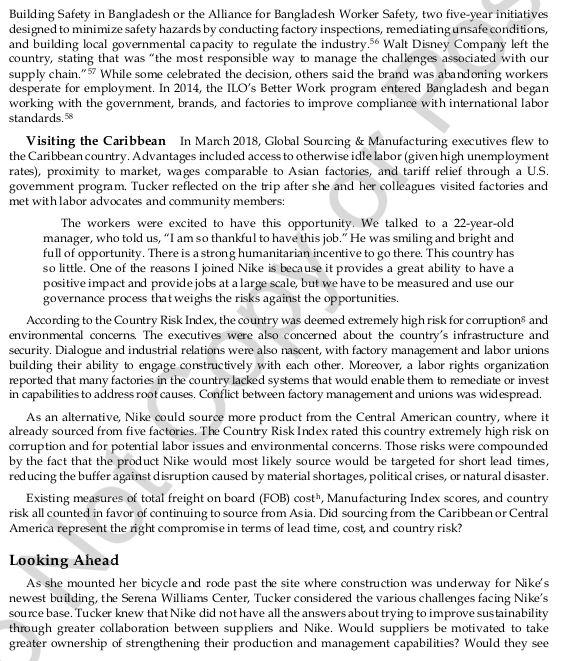

NaE.N-HE MSIE.A MicaA at. W. Tcozsi.1. C.HviA Hu i. Global Sourcing at Nike Nike's Vice President of Sourcing Amanda Tucker stepped outside onto the sportswear giant's Beaverton, Oregon campus in late July 2018 , one month into the 2019 fiscal year. Tucker played a key role in managing Nike's global network of over 500 supplier factories that produced the company's footwear, apparel, and sports equipment. Like many of its competitors, Nike focused on designing, marketing, and distributing its products, and outsourced its production to thirdparty suppliers (see Exhibit 1 for a sample apparel supply chain). Having joined the company in 1999, Tucker had witnessed and participated in an ongoing series of changes in Nike's sourcing practioes that began in 1998, when Nike founder Phil Knight publicly committed to sourcing from suppliers with good working conditions. Tucker reflected on Nike's longterm sourcing model, which it saw as a differentiator in an industry that tended to be broadly transactional in nature, She and her colleagues were focusing on three key supply chain challenges: sourcing from suppliers that meet compliance standards, challenging and encouraging suppliers to improve capa bilities, and being responsive to consumer demand across the world. Nike sought to ensure its suppliers met its sustainability standards that addressed working conditions and environmental impacts, and that they continued to improve their performance along these dimensions. When factories did not meet Nike's standards, decisions had to be made to protect workers while maintaining an agile source base and meeting evolving customer demand for immediate delivery and individual styks. While Nike had historically directed sustainability programs for training suppliers, the brand had begun asking its 'Tier 1 suppliers" to take more initiative in building their management and production capabilities. Nike believed such efforts would not only improve suppliers' accountability for sustaina bility and sustaina bility performance, but would also motivate its suppliers to engage workers in improving their product quality, business performanoe, and ability to partner with Nike in developing innovative products. Not all suppliers, however, shared Nike's enthusiasm for their need to invest in their own factory capabilities. Finally, Nike was in the midst of implementing its new Consumer Direct Offense (CDO) strategy that aimed to increase Nike's responsiveness to consumer demand. As part of this effort, the company was considering adding supplier capacity closer to its North American markets. Where to locate this additional capacity needed to be carefully considered in light of the many opportunities and risks. Nike, Inc. With over $36 billion in 2018 sales and 73,100 employees, Nike was the largest sportswear brand (see Exhibits 2a and 2b for financials). Its product segments included footwear (roughly 64% of sales). apparel ( 31% ), and equipment (4\%).' Sales were concentrated in North America (roughly 43% ), while Europe, the Middle East, and Africa accounted for 27%, Greater China for 14%, and Asia Pacific/Latin America for 15%2 Nike's share of the U.S. sneaker market was 44% in 2017 , while its nearest rival adidas's was 11%.3 Of the top 60 best-selling shoes in the U.S. in 2018,41 were produced by Nike, and 18 by adidas, 4 Competition was steadily intensifying. Arguably the biggest threat was adidas, which had made significant inroads in North America. In the rapidly growing athleisure (athletic-styled leisure) clothing segment, smaller players such as Under Armour had also gained share. A JP Morgan analyst observed that "the industry shift from performance to lifestyle has reduced barriers to entry...and elevated competition in the athletic space.." 5 In June 2017, Nike had launched CDO to establish more direct relationships with customers by "accelerating innovation and product creation, moving even closer to the consumer through Key Cities [New York, London, Shanghai, Beijing, Las Angeles, Tokyo, Paris, Berlin, Mexico City, Barcelona, Seoul, and Milan 1 , and deepening one-to-one connections," according to a Nike press release " 6 The CDO was fueled by the Triple Double Strategy, which sought to: 1) double the cadence and impact of product imovation, 2) double direct connections with consumers by leading with Nike Direct and membership programs, and 3) cut product creation cycle timelines in half to increase speed to consumers. History and Strategy In 1964, Nike founder Phil Knight and his college running coach, Bill Bowerman, started a business importing Japanese footwear. Initially, Blue Ribbon Sports sold Tiger brand running shoes at track meets in Oregon and Washington. In 1971, the company renamed itself Nike, after the Greek god dess of victory, and began designing its own sneakers,7 two years later, saks reached $3.2 million. 8 On the product side, Nike focused on developing high-performanoe athletic wear, starting with its waffle sole sneaker, its air cushion sole, and the industry's first cross-trainer, designed so that "athletes could...play, lift weights and run in one shoe.," Nike designers "got to know the players at the top of the game and did everything we could to understand what they needed, both from a technological and a design perspective," Knight said. " By 2018 , Nike's pwduct innovations included high-tech sneakers with self-lacing capabilities (HyperAdapt), a woven sneaker upper that produced 60% less waste than traditional cut and sew methods (Flyknit), a new foam cushioning sole technology (React), II and an apparel line that adapted to the body's temperature (Tech Pack). In 2017, however, some analysts had expressed concerns that Nike was lagging in innovation, calling its 2016 releases "uninspiring and citing is "lack of compelling product" as a major contributor to retailer Foot Locker's poor 2017 sales 13Nikefelt its recent launches had addressed these concerns. "Our new innovation is winning with consumers, drivingsignificant momentum in our international geographies and a return to growth in North America," said CEO Mark Parker as Nike released its fiscal year 2018 earnings (July 1, 2017 to J me 30, 2018). 14 Professional athletes were central to Nike's product development and testing efforts as well as to its marketing strategy. From the beginning. Nike's marketing campaigns featured successful, charismatic athletes such as track runner Steve Prefontaine and marathon runner Joan Benoit Samuelson. "The trick is to get athletes who not only can win but can stir up emotion, " Knight said. 15 In 2018, Nike had longstanding relationships with celebrity-athletes such as Michael Jordan (basketball). Serena Williams (tennis), and LeBron James (basketball). Analysts with Euromonitor International wrote, "The closer the link in consumers' minds between success and the Nike brand, the easier Nike branded products are to sell at high prices." 16 By 2018 , Nike's swoosh bgo was recognized worldwide and its brand was ranked the 26th most valuable globally. 4 Sourcing was another key component of Nike's strategy. When Blue Ribbon Sports was founded, only 4% of the footwear purchased in the U.S. was made overseas 18 Incumbents Puma and adidas manufactured their shoes in Europe, where labor costs were higher. 19Knight believed that shoes could be produced at lower cost, a strategy he had first outlined in a paper he wrote at Stanford Graduate School of Business titled, "Can Japanese Sports Shoes Do to German Sports Shoes What Japanese Cameras Did to German Cameras?"20 Retaining control over design and marketing, Nike achieved profitable returns by outsourc ing nearly all its manufacturing to lower-cost Asian suppliers. By the mid-1990s, Nike had sourced from suppliers in Japan, South Korea, Taiwan, China, Indonesia, and Vietnam. 21 As The Far Eastern Econawic Revier observed in 1992, "Nike may look like an all-American enterprise, but its success relies on its ability to harness Asia's spectacular manufacturing enterprise." 22 A few years later, The Whstington Post wrote that "Its 30-year history in Asia is as close as any one company's story can be to the history of globalization, to the spread of dollars - and marks and yen - into the poor comers of the earth." 23 Monitoring Compliance with the Code of Conduct (1990-2010) In the early 1990s, Nike faced mounting criticism about the working conditions at its suppliers' factories. In scathing media reports, labor activists accused Nike of tolerating human rights abuses and exploiting underpaid workers. In one of the first reports in 1992, Harper's magazine printed an Indonesian worker s pay slip showing she earned $0.14 per hour. 24 Ina highly-publicized 1997 incident in Vietnam, workers fainted and were hospitalized after a manager made them run laps because they were not wearing regulation shoes. 5A particularly damning article in LIFE magazine in 1996 showed young Pakistani children sewing Nike soccer balls. 26 Though not the only brand to be accused of exploiting workers, Nike's size, profitability, and brand recognition made it a target. Outraged US. college students pressured their universities to cancel collegia te sportswear contracts with Nike. When labor issues first surfaced in 1991, Nike defended itself. "They are our subcontractors," said Nike's General Manager in Indonesia. "I''s not within our scope to investigate lallegations of labor violations ].... I don't know that I need to know." 7 Knight's response focused on Nike's contributions to developing countries' economies: "I think [the] criticism in the media ... [is] really based on lack of understanding of how the world and the economy works, especially by Americans. [The] national economies where Nike has contracted factories have grown enormously. 28 The apparel sector did of fer wages that exceeded those in agricultural and domestic-oriented industries 29 which gave many workers, especially women, the first opportunity to participate in the formal economy, 30 and stimulated the industrialization of many countries economies. 3t As one Indonesian worker described her job at a Nike contract factory to The New York Tines, "It's boring but it's better than being unemployed at home.... I want to be independent....If I stay at home I will be a farmer forever.".32 In the meantime, Nike took steps to better understand factory conditions. In 1992, Nike prod uced its first supplier code of cond uct that specified the company's minimumacceptable workingconditions and soon after started developing a factory monitoring system to assess suppliers' compliance with the code. 33 In 1998 , Knight addressed the situation publicly in a speech at the National Press Club. "The Nike product has become synonymous with slave wages, forced overtime and arbitrary abuse."34 Responding to a reporter's question, he added. "I truly believe that the American consumer does not want to buy products made in abusive conditions." "35 The speech was followed by a series of management steps. The company established a corporate responsibility and compliance division that reported to its public relations unit. A few years later, the organizational structure shifted with the senior director of corporate responsibility reporting to the company President. In 2001, Nike published its first corporate responsibility report, which outlined Nike's process for monitoring more than 700 supplier factories across 50 countries. 3 Nike became one of the first companies to create a board-level corporate responsibility committee, whose meetings Knight attended regularly. (See Exhibit 3 for a timeline showing the evolution of Nike's management of supply chain labor issues.) Then in 2002 , Nike introduced a detailed auditing framework that rated each supplier factory's sadherence to Nike's code of conduct." In 2005 , Nike became the first brand to publish the names of all its supplier factories, 33 contrary to conventional wisdom in the industry that sharing this information would give competitors an advantage. "We believe disclosure of supply chains is a step toward greater efficiencies in monitoring and remediation and shared knowledge in capacity building that will elevate overall conditions in the industry, "said Hannah Jones at the time, then Nike's corporate responsibility vice president. 37 "No one company can solve these issues that areendemic to our industry. We know the future demands more collaboration among stakeholders, not less," she added. Still, like others in the industry, Nike continued to confront code of conduct violations. (See Exhibit 4a for compliance trends and Exhibit 4b for supplier network information.) Some factories improved immediately following audits and were able to sustain those improvements. Others corrected behaviors after an audit revealed violations, only to fall back into noncompliance. In an acute violation to the code of conduct, in 2008 , an Australian television network reported that a Nike supplier factory in Malaysia was engaging in "human trafficking on a majorscale." 41In this instance, Nike found that migrant workers were subjected to subsiandard housing, charged employment fees, and denied access to their passports while sewing apparel for Nike and other brands. 42 (Nike persuaded the factory to reimburse the fees and rebcate workers to appropriate dormitories and required that the workers have access to their passports.) In another incident, in 2010, a Nike supplier in Honduras subcontracted an order-without Nike's permission - to two factories that closed suddenly and failed to pay their 1,800 workers more than $2 million in legally-mandated severance. 43 Nike faced pressure, especially from U.S. college student activists, to pay the severance on behalf of the supplier. These incidents exposed a weakness in Nike's monitoring system-and monitoring in general-that some suppliers engaged unauthorized subcontractors, especially during periods of high demand, often to continue to receive orders after surpassing their production capacity. Nike updated its code of conduct to of ficially prohibit the practice. Changes in Nike's Supply Chain Management Country Risk Index In 2008, a country in the Middle East crossed Nike's radar as a potentially at tractive way to access inexpensive, high-quality cotton. Jones objected due to the country's poor track record on political stability, treatment of women, and corruption. She felt the labor compliance risk would be too high. "If we were going to go into that country," she said, "we were going to have to work with one of our increasingly capable suppliers, versus just going in with hope as a strategy." Up to that point, Nike's Global Sourcing \& Manufacturing department considered country-level conditions such as trade agreements and political risk. To more fully and objectively assess the risks of entering a new country, Nike developed a Country Risk Index that considered eight categories of risk labor, environmental, individual safety, cargo, property, business, economy, and corruption-that could be weighed against other commercial concerns like unit cost or profitability as a whole. The Country Risk Index integrated data from public sources and yielded a rating for each country from 1 (very low risk) to 10 (very high risk). Project Rewire The serious impact to workers of the 2008 Malaysia incident prompted further self-reflection at Nike. Jones recalled, "We realized incremental changes weren't going to get us where we wanted to go. We needed to distupt ourselves. Monitoring finds the problem, but it doesn't solve it." Taking a step back, members of the senior team began to consider the supply chain more holistically with a longterm view of business performance, and to identify the "upstream" factors that influenced factory compliance, in taking a long-term view of business performance. As part of the review, Jones's team began to collect data to make a financial case for assuming greater responsibility for its supply chain. While Nike believed the cost to the brand's reputation was significant when suppliers were exposed violating iis code of conduct, this cost had often been viewed as too intangible to quantify. "We decided to focus on the tangible assets by demonstrating the loss of real dolla is and cents in terms of profitability and tumover when labor compliance failed, "Jones said. "We knew excessive vvertime affected a factory's product quality, worker turnover, and prod uctivity." In 2009, Nike introduced a new initiative, dubbed Project Rewire, around a central hypothesis: that Nike could create a profitable supply chain in which social and environmental metrics wereconsidered alongside financial metrics. At the time, Gbbal Sourcing \& Manufacturing made sourcing decisions balancing the three criteria of cost, quality, and delivery speed, while the Corporate Responsibility department monitored supplier compliance with its code of conduct. Nike was not unusual in dividing responsibilities this way; scholars observed that at many brands "sourcing decisions are often decoupled from the enforcement of private regulation [such as codes of conduct], resulting in a tension between these two functions" and that it was "not uncommon to hear complaints from social compliance managers that their mission is not taken seriously by their colleagues in purchasing departments." 44 Project Rewire called for an internal restructuring that created Sustainable Ma nufacturing \& Sourcing (SM\&S), a new department within Global Sourcing \& Manufacturing, to oversee factory compliance and capability building. The shift further elevated sustainability at Nike, SM\&S would have the same status as the Apparel Manufacturing \& Sourcing and Footwear Manufacturing \& Sourcing departments that oversaw manufacturing processes, capabilities, and overall strategy for apparel and footwear suppliers. Jones saw the change as a worthwhile but risky experiment "I was really worried about the fox guarding the henhouse," she recalled. To address this concern, Nike provided a series of checks and balances that included dotted line reporting of SM\&S to Jones and the creation of a separate function designed to audit the auditors. The Manifacturing Index Created in 2012, the Manufacturing Index was a sourcing tool that rated suppliers on their performance in four areas - cost, quality, delivery, and sustainability, putting environmental and labor commitments on equal footing with cost, quality and delivery. In introducing the tool, Nike leadership sought to demonstrate the brand's commitment to a holistic approach to sourcing, and align suppliers' incentives with its own. The Manufac turing Index rated each factory and each supplier group (a group of factories that shared anowner) along each of the four criteria ona 1 to 100 scale, which corres ponded to one of five color ratings: red, yellow, bronze, silver, and gold (see Exhibit 5a for the Manufacturing Index and Exhibit 5 b for a sample scorecard using disguised data). For sustainability, bronze meant a supplier factory met. Nike's compliance requirements, silver meant that it made consistent improvements beyond compliance requirements, and gold recognized manufacturing standards that were viewed as world class regard less of industry. When the Manufacturing Index was first launched, the scores were averaged across the four criteria to assign an overall supplier faclory rating. The ratings informed and directed purchasing decisions. When placing an order. Nike would prioritize supplier factories with the highest ratings. Reorganizing Global Souring \& Mantifacturing In 2017, Nike created a new role to help oversee its entire source base: Gbbal Sourcing \& Manufacturing's first VP of Sourcing. The role would report to Gerry Rogers, the VP of Global Sourcing \& Manufacturing, and would be parallel to Rogers's other direct reports, which included VP of SM\&S Noel Kinder, VP of Apparel Manufacturing \& Sourcing Ernie Rose, and VP of Footwear Manufacturing \& Sourcing Greg Bui. Rogers, in turn, reported to COO Eric Sprunk. Rogers and Sprunk of fered the new position to Amanda Tucker. By that time, Tucker had been with Nike almost two decades. Before Nike, she earned postgraduate degrees from the Paris Institute of Political Studies (Sciences Po) and the College of Europe in Belgium, and developed expertise in working conditions in developing country contexts dating back to the 1990 s when she worked at the International Labor Organization's (ILO) program to eliminate child labor, overseeing operations in East Africa and Southeast Asia. At the time, the Pakistani soccer ball industry was under scrutiny due to child labor allegations, and sporting goods brands came to the ILO for help. "I spent months in Sialkot, Pakistan working to transition a home-based industry into a monitorable industry," she said. She had joined Nike in 1999 in the then-nascent Labor Practices department to help develop the company's code of conduct and audit protocols, and subsequently worked in Global Sourcing \& Manufacturing as the general manager of footwear in Vietnam and then in Italy. Along the way, she enrolled in Stanford's full-time MBA program on a corporate scholarship where she was tasked by Nike to help develop the sustainability standards for what would become the Manufacturing Index. In her new role of VP of Sourcing, Tucker would kad the department that was responsible for ensuring Nike had enough contracted capacity to satisfy Nike's production needs, deciding where to place orders and at what quantities. Rogers explained why Tucker was a good fit: "We wanted to put all the responsibility under one leader who was well-versed in the architecture of our compliance, but had also run big product creation divisions. As someone who understands both sides, she can make holistic decisions." "Tucker's new responsibilities included decisions that had previously been made by the VPs of Apparel Manufacturing \& Sourcing and Footwear Manufacturing \& Sourcing, who going forward would instead increase their focus on developing the manufacturing and financial capabilities of suppliers to satisfy Nike's innovation needs and quality standards in areas such as product creation, automation, chemical engineering, and ma nufacturing engineering. Sourcing decisions would be made jointly: Sourcing would propose volumes and locations, and Apparel Manufacturing \& Sourcing and Foot wear Manufacturing \& Sourcing would confirm that suppliers had the capacity to deliver. of factories that shared anowner) along each of the four criteria ona 1 to 100 scale, which corres ponded to one of five color ratings: red, yellow, bronze, silver, and gold (see Exhibit 5a for the Manufacturing Index and Exhibit 5 b for a sample scorecard using disguised data). For sustainability, bronze meant a supplier factory met. Nike's compliance requirements, silver meant that it made consistent improvements beyond compliance requirements, and gold recognized manufacturing standards that were viewed as world class regard less of industry. When the Manufacturing Index was first launched, the scores were averaged across the four criteria to assign an overall supplier faclory rating. The ratings informed and directed purchasing decisions. When placing an order. Nike would prioritize supplier factories with the highest ratings. Reorganizing Global Souring \& Mantifacturing In 2017, Nike created a new role to help oversee its entire source base: Gbbal Sourcing \& Manufacturing's first VP of Sourcing. The role would report to Gerry Rogers, the VP of Global Sourcing \& Manufacturing, and would be parallel to Rogers's other direct reports, which included VP of SM\&S Noel Kinder, VP of Apparel Manufacturing \& Sourcing Ernie Rose, and VP of Footwear Manufacturing \& Sourcing Greg Bui. Rogers, in turn, reported to COO Eric Sprunk. Rogers and Sprunk of fered the new position to Amanda Tucker. By that time, Tucker had been with Nike almost two decades. Before Nike, she earned postgraduate degrees from the Paris Institute of Political Studies (Sciences Po) and the College of Europe in Belgium, and developed expertise in working conditions in developing country contexts dating back to the 1990 s when she worked at the International Labor Organization's (ILO) program to eliminate child labor, overseeing operations in East Africa and Southeast Asia. At the time, the Pakistani soccer ball industry was under scrutiny due to child labor allegations, and sporting goods brands came to the ILO for help. "I spent months in Sialkot, Pakistan working to transition a home-based industry into a monitorable industry," she said. She had joined Nike in 1999 in the then-nascent Labor Practices department to help develop the company's code of conduct and audit protocols, and subsequently worked in Global Sourcing \& Manufacturing as the general manager of footwear in Vietnam and then in Italy. Along the way, she enrolled in Stanford's full-time MBA program on a corporate scholarship where she was tasked by Nike to help develop the sustainability standards for what would become the Manufacturing Index. In her new role of VP of Sourcing, Tucker would kad the department that was responsible for ensuring Nike had enough contracted capacity to satisfy Nike's production needs, deciding where to place orders and at what quantities. Rogers explained why Tucker was a good fit: "We wanted to put all the responsibility under one leader who was well-versed in the architecture of our compliance, but had also run big product creation divisions. As someone who understands both sides, she can make holistic decisions." "Tucker's new responsibilities included decisions that had previously been made by the VPs of Apparel Manufacturing \& Sourcing and Footwear Manufacturing \& Sourcing, who going forward would instead increase their focus on developing the manufacturing and financial capabilities of suppliers to satisfy Nike's innovation needs and quality standards in areas such as product creation, automation, chemical engineering, and ma nufacturing engineering. Sourcing decisions would be made jointly: Sourcing would propose volumes and locations, and Apparel Manufacturing \& Sourcing and Foot wear Manufacturing \& Sourcing would confirm that suppliers had the capacity to deliver. Tucker acknowledged it would be challenging for the new Sourcing group to create a strategy that worked for all product segments. In footwear, Nike aimed to balance its order volume across supplier factories because many of these factories produced exclusively for Nike "If the demand dips for one product and we can't fill it, that has a big impact on them," Tucker said. " In footwear, the sourcing role bleeds into a supply planning role." Apparel suppliers, meanw hile, typically had other customers. "If demand dips, we tell them early enough so they can get another customer." Global Sourcing at Nike in 2018 Nike's supply chain expected to ship 13 billion units of product in fiscal year 2018. To do so, Nike worked with more than 500 supplier factories across 41 countries that employed more than 1 million people, 80% of whom were women (see Exhibit 6 for a map), in 2018 , Nike apparel was supplied by 328 factories, with half the volume produced in China, Vietnam and Thailand, and the remainder in 34 other countries. Nike footwear was supplied by 124 factories, with 94% of the volume produced in Vietnam, China and Indonesia, and the remainder in 10 other countries. This reflected a significant reduction in the number of suppliers in its source base since 2009, when Nike worked with more than 1,000 factories, and an increased commitment to maintaining longer-term relationships with suppliers. Some of the strategic footwear suppliers had produced Nike shoes for over 30 years, including one with 42 years supplying to Nike. Nike believed that with fewer suppliers, it could focus on approaches with a long-term business view, including: selecting the optimal countries to source from: improving internal executive and operational governance mechanisms; prioritizing suppliers that invest in capa bility building: and increasing Nike's proximity to market. "By consolid ating our source base to fewer suppliers that share our values and are positioned to grow with us, we are better able to deepen relationships and built trust because they know we are going to be there for the long-term," Rose said. This long-term strategy included an effort to engage collaboratively at the supplier headquarters level. Starting in 2014, Nike began building mechanisms to engage supplier headquarters offices in Nike's strategies and plans, increasing the level of transparency between the two parties in planning. for example, and driving shared values and deliverables, such as in the shared delivery of some sustainability targets. Likewise, Nike evolved the Manufacturing Index formula to increase the salience of supplier level accountability on sustainability! if a factory's sustainability rating was red or yellow, falling below compliance standards, the overall rating of the factory's supplier group was automatically red or yeliow, regardless of their scores in the quality, delivery and cost quadrants and regardless of how the other individual factories in their network were performing. Nike executives expected suppliers to make a business-wide investment in sustainability. Nike released products during four seasons: spring, summer, fall, and holiday. Planning for a new season typically began two years in ad vance when the Categories \& Product department developed the plans for a product line and set a target for manufacturing costs. Global Sourcing \& Manufacturing determined which factories would produce which products for which seasons. The planning teams then secured production capacity across the source base to ensure that it could accommodate demand for that product. Finally, Categories \& Product placed purchase orders, initiating the production process. Products were shipped to Nike's distribution centers, which took over three weeks. Overall, it typically took 6 to 18 months to bring a new apparel or footwear style to market, depending on product complexity, though some unique products, with advanced research, development and design elements, took much longer-HyperAdapt took 10 years. 45 While Global Sourcing \& Manufacturing was responsible for executing against the Manufacturing Index, Categories \& Product had different key performanoe indicators that included gross product margin, revenue, units, style count, and productivity. Rose explained, "Categories track against a margin for each season's overall product portfolio, while Global Sourcing \& Manufacturing is incentivized to consider total cost. The product teams have to trust that their products are going into the right factories. There is always a dynamic, prod uctive tension bet ween the two." More than any of her previous roles, Tucker's new role gave her an appreciation for the tensions embedded in a supply chain. "Sourcing is a balancing act. No one is fully happy with anything you do," Tucker said. "Every time we go to a factory, the management wants more orders, or a different model mix. Some want higher margins or simpler designs. Others want a chance to produce the inmovative products because they are eager to develop and grow. On the sustainability side, there is always something they could be doing better." Internally, Tucker and her team sought to push Categories \& Product to adjust to Nike's goal of adding production capacity near-shore, but their margin targets of ten conflicted with doing so. "At times, we would hit internal resistance because you're asking Categories to go with a supplier they don't know as well and to pay a higher price, and that seems counter-intuitive to them based on how we operated in the past," Tucker said. "But everyone is learning that we have shifted out of a low-price, short-term model. We now take into account many factors for selection and sourcing, inciuding sustainability, distance to market, and duties so we can compete on innovation, service, and consumer experience. With this shift, the supplier relationship becomes even more critical because suppliers need to have greater knowledge of Nike's growth plans and capability needs." As she worked to advance this shift, Tucker anticipated challenges in three areas: supplier compliance, supplier capability, and geographic diversity. Promoting Supplier Compliance Factories were audited at least once every 12 months by Nike and third-party auditors to assess employment, occupa tional health and safety, and environmental management practices (see Exhibit 7 for an overview of the topics covered in an audit). Audits averaged three staff days and cost factories approximately $5,000. N Nike's audit protocol included 3,000 questions, which attempled to elicit detailed information about factory operations, for exa mple to learn how workers were trained to use protective equipment, whether factory doors were locked during working hours, how they disposed of waste, and what steps they took to provide ergonomic workstations that reduced employee injury. Audit results informed factories' sustainability scores on the Manufacturing Index. Half of Nikefactories met compliance standards scoring bronze or higher on the sustainability quadrant in 2011 , but this nearly doubled to 91 " by the end of 2017. When a factory was found to be noncompliant, Nike would work with factory managers to see that corrective actions were taken, that problems were remediated and that the managers had on-site verification of this remediation. After 2016 , factories were expected to independently remediate their noncompliances, and Nike was no bonger defining or approving their corrective action plans. If auditsscheduled more frequently after red or yellow ratings-contimued to surface serious or zero-tolerance issues, Gbbal Sourcing \& Manufacturing called a meeting with factory management. Doning suits, Global Sourcing \& Manuf acturing executives scrutinized managers' attitudes for willingness to change. "You know sitting across the table," Rogers said. "You know the level of engagement, the level of openness. If it's adversarial, if there's denial involved, we can tell. If the attitude is wrong, they're just paying lip service and kicking the can down the road." Global Sourcing \& Manufacturing reviewed factories with compliance violations - those rated red or yellow - at quarterly Source Base Review meetings. Sanctions If a factory failed to fix severe problems or exhibited the same violations repeatedly, Nike would impose sanctions. Sanctions most often included slowing a supplier's growth plan, withholding orders of models that the supplier had hoped to produce, and removing the "strategic supplier group" status reserved for su pplier groups aligned with Nike's management philosophy who wanted to grow with Nike. Nike intended for its sanctions to not be punitive, but rather to reduce the factory's production level to allow it to focus on remediation. "We are not trying to inflict needless pain," Tucker said. "We don't want them to have to lay off workers and we go to great lengihs to ensure workers are minimally negatively affected by the sanctions. Instead, we are trying to send a signal and create space to develop capabilities that will lead to positive change in how they value their workforce and how they run their business." Rogers elaborated: The ability to find the right capability around the world is actually quite finite. Particularly in this industry where you have tremendous product specialization. It's not in anyone s interest to engage transactionally and walk away every time there is a problem. As these companies grow, they come up against new obstacles that we can actually help them with by showing best practice capability building or collaborating together. We want the suppliers to remediate. You change the relationship when you allow them to remediate to stay in the source base. It's good for workers, the supplier, and for Nike's business. Nike leadership felt it could do more to improve factory practices and working conditions by maintaining a sourcing relationship. Roughly one to three times per year, however, Nike removed a factory from its source base due to labor code violations. d Nike provided advance notice to the factory when it intended to terminate the relationship, and collaborated with the factory to jointly develop a ramp-down plan. The timeline for the ramp-down was jointly negotiated with the factory and, in most instances, allowed a minimum exit notice of six months though it could last as long as two years. The impact of sanctions was not only external. Sanctions also could exacerbate tensions between Sourcing and Categories \& Product, especially when they coincided with unexpectedly high demand. Footwear Factory In late 2017, Nike received an anonymous phone call alleging that a footwear factory had been scheduling workers to work overtime that was not compensated at overtime levels. Following its established protocols, Nike investigated the matter. On prior audits, the factory had achieved bronze ratings. The latest audit confirmed underpaid overtime as well as excess overtime. It also uncovered two sets of accounting books - one for internal purposes and another to show brands' auditors. Nike immediately cancelled the order to produce 400,000 units. Nike sanctioned the factory by flattening its projected growth in Nike orders for the subsequent four seasons. Nike also considered sanctions against the entire supplier group; although this was the factory's first compliance failure, another factory in the supplier group had yo-yoed in and out of compliance. Nike considered imposing a supplier group-wide sanction by removing its status as a strategic supplier. In response, the supplier group commenced a review of its factory operations, and began to consider standardized procedures managers with someone who had proven experience in other locations. Global Sourcing \& Manuf acturing planned to monitor the group closely going forward. At the time, Nike was in the midst of a period of significant growth in demand and there was limited capacity to address unanticipated jumps in demand for this particular footwear product. Demand had increased by approximately 20% compared to the previous year and shortly after the sanction was established, demand jumped again by over 10%. In add ition to reduced capacity to meet demand, Nike incurred freight costs to meet the launch date and approximately 400,000 pairs of shoes were delivered to merchants late by almost a month. When products were delayed, Nike's retail and wholesale customers cancelled their orders, forcing Nike to discount the product in order to sell it quickly to other accounts or directly to customers. Given this context, Nike estimated that cancelling the order led to delays that resulted in millions of dollars in lost profit margin. Specialty Supplier In A pril 2017, a factory audit revealed that a supplier of a highly specialized product violated migrant labor laws. One in ten workers at the factory had paid high fees in order to work at the factory (a clear code violation), and the factory had failed to cover the costs as required. In addition, the factory had failed to reimburse workers for their housing costs, even though they had been promised accommodation in their employment contracts. The previous four audits had revealed repeated instances of excess overtime, substandard dormitory conditions, and repeated failures to pay housing costs and reimburse hiring costs, and in each instance factory management had remediated those problems within timelines Nike deemed acceptable, and had worked with Nike teams to track completion. In 2015, the factory had also been cited for charging fees to migrant workers who decided to return home before their employment contracts had finished, and this was also remed iated. The factory, which employed 1,000 people, was part of a long-term, strategic supplier group. At the time, the factory was exclusively manufacturing for Nike. After securing buy-in from several executives, Sourcing decided to sanction the entire group by freezing orders at current levels for the next three years. Previously, Nike had planned to increase its purchase orders with that group each year for three years. Nike warned the group that the next failed audit would result in termination. However, as soon as Nike informed the factory of the sanction, product demand spiked. Forecasts had originally pegged expected growth for the factory's key prod uct at approximately 10%, but trends showed that demand would actually grow at a faster rate. Finding alternative capacity was especially challenging given the scale of the demand spike, the specialization of the product, and the fact that other brands would also be experiencing the same demand spike for that product category and chasing the same capacity. Despite alignment on the decision to sanction, it was a challenging situation. Tucker recalled, "We had a very real capacity constraint and there was an awareness that we could be at risk of potentially walking away from revenue because we wouldn't have enough of this prod uct." Building Supplier Capability Nike executives believed that enhancing suppliers' production and ma nagement capabilities would improve working conditions and suppliers' sustainability performance. They also anticipated other ripple effects: that factories with stronger capabilities and greater worker engagement would be able to produce higher quality products and be better suppliers to Nike to develop innovative products. "If the worker comes to work every day feeling valued, they're going to do the best job," Sprunk said. While initially the brand was heavily involved in training suppliers, Nike shifted its approach with the aim to encourage factories to take ownership for their own training and invest in their own capabilities. Nike leadership believed this approach would promote more sustainable and scalable learnings that could be extended beyond Nike production lines. Lean 1.0 In 2002, Nike worked with one of its leading footwear suppliers to deliver in-factory training in lean manufacturinge techniques - primarily focused on the manufacturing process - in an effort to improve delivery speed and productivity. By 2011, 80% of its footwear suppliers were implementing this Lean 1.0 program. 46 On the apparel side, Nike began offering training in lean manufacturing in 2005. In 2009, Nike opened the A pparel Innovation and Training Center (AITC) in collaboration with one of its lead apparel suppliers inside a factory in Sri Lanka. At the AITC, factory managers of Nike's large, long-term apparel supplier groups were invited to participate in a 12-week, Nike-led course in lean manufacturing. Suppliers paid tuition plus room and board, and graduates were expected to implement lean methods. In addition to productivity, evidence suggested that lean training improved factories compliance with Nike's code of conduct. One study of Nike's apparel suppliers found that "on average, serious violations of labor standards fell by fifteen percentage points, from 40% of factories to 25%%2 " The study's author wrote, "While the production system requires more worker skill and effort, employers have incentives to retain these valuable workers through improved working conditions." 48 Lean 2.0 In 2014-2015, following a series of pilots in Indonesia, AITC courses shifted to also include (1) worker engagement and wellbeing, and (2) leadership and management capabilities, an approach Nike referred to as "Lean 2.0." (See Exhibit 8 for an example of worker engagement through the Culture of Safety.) The AITC became a training center for both apparel and footwear. Initial results indicated that Lean 2.0 improved worker conditions and business performance in key areas. The Worker Engagement Pilot that informed the Lean 2.0 approach was credited with increasing productivity within one factory by 19%. Quality levels increased by 7%, and workers anonymously self-reported that they felt 22% better valued on the pilot lines. When Lean 2.0 was then adopted in eight footwear factories as part of implementing more mechanized production, within six months, two of the factories tripled productivity, as measured by pairs of shoes per shift. Worker conditions also improved: another factory achieved a period of 600 days with no recordable safety incident, including near misses. Among apparel factories adopting Lean 2.0, one factory reduced its manufacturing lead time by about 40%, accelerating the production of 92% of its overall volume and smoothing delivery demand spikes at the operator level. After conducting pilots in 16 factories and drawing together best practices on safety, the methodology and results were codified into manuals made available to all suppliers. Suppliers could participate in additional two-week or 12 -week residential training programs; the 12 -week program cost roughly $10,000 and included a four-week factory session hosted by one of the participating suppliers. Nike also worked directly with eight supplier groups as they increased automation in their production processes. These eight groups received customized Lean 2.0 training and subsequent support based on their strategic goals. By 2018, the management of factories that produced 83% of Nike's total unit volume had received Lean 2.0 training and more planned to be trained. Scaling In addition to Lean and worker engagement, Nike supported capability building opportunities in areas such as modernization (e.g., recent technological improvements) and environment (e.g., waste, carbon and water reduction) (see Exhibit 9 for selected supplier capability building discounted those products, which threatened the brand's premium pricing strategy and risked encouraging consumers to postpone purchasing Nike products in the hopes of finding a better price. In response, Nike hoped to use consu mer behavior as its demand signal rather than retailers' orders. To do this, it would have to reduce lead times for some products in part by adding new production capacity closer to consu mer markets. Transporting products far distances was a source of big delays for Nike. For example, a product manufactured in Asia might take 45 days to travel to Argentina, while a product manufactured in Central America would only take one week. One expected growth area through CDO was in the U.S. market. Recently, one of Nike's larger apparel suppliers had acquired capacity in a Central A merican country and a Caribbean country and encouraged Nike to source from them to support the desire to reduce lead time for the U.S. market. Nike had some risk concerns about the geography and considered the Country Risk Index, as well as the local factories' capabilities, capacity, pricing (including all costs to manufacture and transport product to market), and labor compliance (see Exhibit 10 for a chart showing disguised data that compares sample factories in Asia, Central America, and the Caribbean). Calling on Experience Global Sourcing \& Manufacturing recalled its experience in 2013 with Bangladesh, the second-largest clothing exporter. Nike's presence there was small with seven factories. "Our competitors were moving fast into Bangladesh and the pressure was getting bigger and bigger," said Sprunk. 51 "We needed a strong point of view to say, 'Are we going to increase our source base or not?" 52 From a production cost perspective, the case was clear. Garment sector workers' monthly wage was $37, among the lowest minimum wages in the world. 53,f Bangladesh was also a preferred location for a relatively rare product classification-down-filled garments such as jackets. However, Nike's Country Risk Index ranked Bangladesh among the riskiest countries, especially in the areas of labor (potential for child labor, migrant workers, forced labor, and inadequate wages) and corruption (presence of corruption, lack of anti-corruption legislation, or lack of efficacy in anti-corruption efforts). A fire in 2012 that killed 112 workers in a factory where Nike did not source product made the picture look even grimmer. "We had a really difficult internal conversation," Jones recalled. "We butted heads and came to a bit of an impasse." Following that incident executives organized a trip to Bangladesh to visit the burnt-down factory as well as Nike suppliers inside and outside the Export Processing Zone (EPZ), a government-sanctioned manufacturing area. The team was not impressed by the factories, especially those outside the EPZ, which were mostly converted apartment buildings that appeared to have poor health and safety conditions. In one, they found an embroidery unit in a windowless garage. "Sometimes you have to go and see for yourself," Jones said. "You can remain somewhat removed from data until you actually observe the factory floor." At the end of the trip, the team reached a consensus: instead of expanding its source base in Bangladesh, Nike would reduce its source base and only source from EPZ factories. "Labor is really only a small portion of your total cost and, for us, it doesn't make sense to chase it. You also need to factor in the cost of disruption, cost of noncompliance, cost of productivity, cost of low quality, volatility, "Jones said. Added Rose, "We are a long-term player, and health and safety, compliance, quality, and innovation will always provide a foundation for long-term performance versus short-term pricing reactivity." Six months later the industry suffered a massive tragedy. In just 90 seconds, the Rana Plaza building, located outside the EPZ, collapsed and killed 1,134 factory workers. 54 Investigations revealed that the building had been poorly constructed on top of a former swamp. 55 The disaster prompted commitments to improve factory conditions. Approximately 250 firms joined the Accord on Fire and Building Safety in Bangladesh or the Alliance for Bangladesh Worker Safety, two five-year initiatives designed to minimize safety hazards by conducting factory inspections, remed iating unsafe conditions, and building local governmental capacity to regulate the industry. 56 Walt Disney Company left the country, stating that was "the most responsible way to manage the challenges associated with our supply chain." 57 While some celebrated the decision, others said the brand was abandoning workers desperate for employment. In 2014, the ILO's Better Work program entered Bangladesh and began working with the government, brands, and factories to improve compliance with international labor standards. 58 Visiting the Caribbean In March 2018, Global Sourcing \& Manufacturing executives flew to the Caribbean country. Advantages included access to otherwise idle labor (given high unemployment rates), proximity to market, wages comparable to Asian factories, and tariff relief through a U.S. govemment program. Tucker reflected on the trip after she and her colleagues visited factories and met with labor advocates and community members: The workers were excited to have this opportunity. We talked to a 22-year-old manager, who told us, "I am so thankful to have this job." He was smiling and bright and full of opportunity. There is a strong humanitarian incentive to go there. This country has so little. One of the reasons I joined Nike is because it provides a great ability to have a positive impact and provide jobs at a large scale, but we have to be measured and use our governance process that weighs the risks against the opportunities. According to the Country Risk Index, the country was deemed extremely high risk for corruptions and environmental concerns. The executives were also concerned about the country's infrastructure and security. Dialogue and industrial relations were also nascent, with factory management and labor unions building their ability to engage constructively with each other. Moreover, a labor rights organization reported that many factories in the country lacked systems that would enable them to remediate or invest in capabilities to address root causes. Conflict between factory management and unions was widespread. As an alternative, Nike could source more product from the Central American country, where it already sourced from five factories. The Country Risk Index rated this country extremely high risk on corruption and for potential labor issues and environmental concerns. Those risks were compounded by the fact that the product Nike would most likely source would be targeted for short lead times, red ucing the buffer against disruption caused by material shortages, political crises, or natural disaster. Existing measures of total freight on board (FOB)sth, Manufacturing Index scores, and country risk all counted in favor of continuing to source from Asia. Did sourcing from the Caribbean or Central America represent the right compromise in terms of lead time, cost, and country risk? Looking Ahead As she mounted her bicycle and rode past the site where construction was underway for Nike's newest building, the Serena Williams Center, Tucker considered the various challenges facing Nike's source base. Tucker knew that Nike did not have all the answers about trying to improve sus tainability through greater collaboration between suppliers and Nike. Would suppliers be motivated to take greater ownership of strengthening their production and management capabilities? Would they see the benefits of improved quality, productivity, and ability to collaborate with Nike in innovation? How should the brand integrate its existing sourcing tools with a need to source product closer to market? "My whole professional life I have aligned myself with people and organizatons that are trying to get better working conditions," she said. "In my new role I have a unique view across the entire supply chain. Nike understands how complex and integrated these decisions are, and also the incredible opportunity we have to drive positive change both for Nike and for the people who make our shoes and clothes
Step by Step Solution
There are 3 Steps involved in it
Step: 1

Get Instant Access to Expert-Tailored Solutions
See step-by-step solutions with expert insights and AI powered tools for academic success
Step: 2

Step: 3

Ace Your Homework with AI
Get the answers you need in no time with our AI-driven, step-by-step assistance
Get Started


